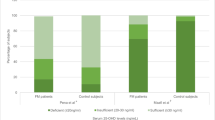Abstract
Fibromyalgia is a complex problem in which symptoms of anxiety and depression feature prominently. Low levels of vitamin D have been frequently reported in fibromyalgia, but no relationship was demonstrated with anxiety and depression. Seventy-five Caucasian patients who fulfilled the ACR criteria for fibromyalgia had serum vitamin D levels measured and completed the Fibromyalgia Impact Questionnaire (FIQ) and Hospital Anxiety and Depression Score (HADS). Deficient levels of vitamin D was found in 13.3% of the patients, while 56.0% had insufficient levels and 30.7% had normal levels. Patients with vitamin D deficiency (<25 nmol/l) had higher HADS [median, IQR, 31.0 (23.8–36.8] than patients with insufficient levels [25–50 nmol/l; HADS 22.5 (17.0–26.0)] or than patients with normal levels [50 nmol/l or greater; HADS 23.5 (19.0–27.5); Kruskal–Wallis ANOVA on ranks p<0.05]. There was no relationship with global measures of disease impact or musculoskeletal symptoms. Vitamin D deficiency is common in fibromyalgia and occurs more frequently in patients with anxiety and depression. The nature and direction of the causal relationship remains unclear, but there are definite implications for long-term bone health.
Similar content being viewed by others
References
Wolfe F, Ross K, Anderson J, Russell, IJ, Herbert L (1995) The prevalence and characteristics of fibromyalgia in the general population. Arthritis Rheum 38:19–28
Al-Allaf AW, Mole PA, Paterson CR, Pullar T (2003) Bone health in patients with fibromyalgia. Rheumatology (Oxford) 42:1202–1206
Swezey RL, Adams J (1999) Fibromyalgia: a risk factor for osteoporosis. J Rheumatol 26:2642–2644
Jensen B, Wittrup IH, Bliddal H, Danneskiold-Samsoe B, Faber J (2003) Bone mineral density in fibromyalgia patients—correlation to disease activity. Scand J Rheumatol 32:146–150
Macfarlane GJ, Palmer B, Roy D, Afzal C, Silman AJ, O’Neill T (2005) An excess of widespread pain among South Asians: are low levels of vitamin D implicated? Ann Rheum Dis 64:1217–1219
Wolfe F, Smythe HA, Yunus MB et al (1990) The American College of Rheumatology 1990 criteria for the classification of fibromyalgia: report of the multi-center criteria committee. Arthritis Rheum 33:160–172
Burckhardt CS, Clark SR, Bennett RM (1991) The fibromyalgia impact questionnaire: development and validation. J Rheumatol 18:728–733
Aylard PR, Gooding JH, McKenna PJ, Snaith RP (1987) A validation study of three anxiety and depression self-assessment scales. J Psychosom Res 31:261–268
Simonelli C, Weiss TW, Morancey J et al (2005) Prevalence of vitamin D inadequacy in a minimal trauma fracture population. Curr Med Res Opin 21:1069–1075
Sewitch MJ, Dobkin PL, Bernatsky S, Baron M, Starr M, Cohen M, Fitzcharles M-A (2004) Medication non-adherence in women with fibromyalgia. Rheumatology (Oxford) 43:648–654
Dobkin PL, Abrahamowicz M, Fitzcharles MA, Drista M, da Costa D (2005) Maintenance of exercise in women with fibromyalgia. Arthritis Rheum 53:724–731
Landsdowne AT, Provost SC (1998) Vitamin D3 enhances mood in healthy subjects during winter. Psychopharmacology (Berl) 135:319–323
Perez-Fernandez R, Alonso M, Segura C, Munoz I, Garcia-Caballero T, Diguez C (1997) Vitamin D receptor gene expression in human pituitary gland. Life Sci 60:35–42
Acknowledgements
The authors wish to acknowledge the assistance of Mrs. Norma Parker and Miss Clara Rose Armstrong in the collection and processing of the data.
Author information
Authors and Affiliations
Corresponding author
Rights and permissions
About this article
Cite this article
Armstrong, D.J., Meenagh, G.K., Bickle, I. et al. Vitamin D deficiency is associated with anxiety and depression in fibromyalgia. Clin Rheumatol 26, 551–554 (2007). https://doi.org/10.1007/s10067-006-0348-5
Received:
Revised:
Accepted:
Published:
Issue Date:
DOI: https://doi.org/10.1007/s10067-006-0348-5



